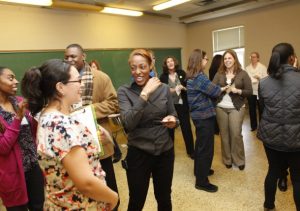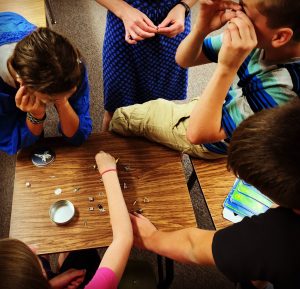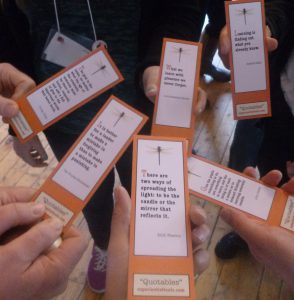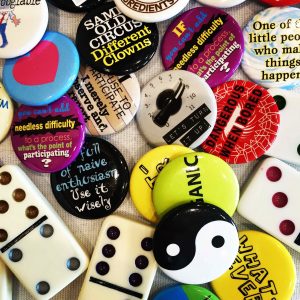Aug 23, 2018 Start Off With Style: Create a Hook to Engage
 Think back to your most memorable learning experiences— the courses, team-building programs, or classes you enjoyed and the facilitators or educators you found most impactful. How did they start their classes or workshop sessions? How did they begin the program? How did they greet you when you arrived? Chances are, they created a compelling way to draw you into the learning experience.
Think back to your most memorable learning experiences— the courses, team-building programs, or classes you enjoyed and the facilitators or educators you found most impactful. How did they start their classes or workshop sessions? How did they begin the program? How did they greet you when you arrived? Chances are, they created a compelling way to draw you into the learning experience.
The first few minutes of an experience or lesson are a key time to hook and engage learners. Evidence shows that people remember most about the first few minutes of an experience, and secondly the last few minutes of experiences (Willis, 2010b, 2010). Some educators and cognitive neuroscientists call this the primacy-recency effect (Sousa, 2006). John Medina, author of Brain Rules, states: “If you are trying to get information across to someone, your ability to create a compelling introduction may be the most important single factor in the later success of your mission” (2008, p. 116). This information validates the importance of facilitating an engaging opening activity and providing a meaningful reflection prompt to tie it all together or “bookend” a learning experience.  When a group is coming together for the first time, participants can feel awkward. For many facilitators and educators, the first few moments of a workshop or class can be chaotic or filled with administrative duties. In the U.S., people are often late to workshops/programs and the entry time from the first person arriving to the last can extend for as much as 20 minutes or more. Unexpected issues with space, logistics and administrative duties come up in the first few moments of group time. In school settings, attendance has to be sent to the office; on challenge courses, release forms have to be filled out. Take advantage of the primacy-recency effect by being thoughtful about how one facilitates these first moments of experience. There are a number of approaches that can help a facilitator address housekeeping or logistics and still engage and welcome their group in a meaningful way.
When a group is coming together for the first time, participants can feel awkward. For many facilitators and educators, the first few moments of a workshop or class can be chaotic or filled with administrative duties. In the U.S., people are often late to workshops/programs and the entry time from the first person arriving to the last can extend for as much as 20 minutes or more. Unexpected issues with space, logistics and administrative duties come up in the first few moments of group time. In school settings, attendance has to be sent to the office; on challenge courses, release forms have to be filled out. Take advantage of the primacy-recency effect by being thoughtful about how one facilitates these first moments of experience. There are a number of approaches that can help a facilitator address housekeeping or logistics and still engage and welcome their group in a meaningful way.
Learners of all ages come to the classroom or group room with things on their mind (e.g., a stressful commute, a rough morning at home, a negative social interaction in the hallway, ambivalence about the program itself). A reflective focusing activity can welcome participants coming together for the first time and help them transition into the learning space.
Find a Hook!
Engage learners from the moment they walk in the door by using objects, images, or quotes. This creates an opportunity for participants to make positive connections with their peers, set up context around the upcoming experience or lesson, begin the process of reflection, and shift their focus to the here and now.  I developed two of my favorite facilitation tools out of this desire for engaging groups from the moment they walk in the door. The Quotables and Conversation Starters Buttons. Quote cards can be used as an engaging introductory, transitional, or reflective activity. They are useful for creating context and framing an experience. I encourage facilitators to choose quotes that relate to the theme of a program, the subject being explored, or goals of the group. Reflecting upon and discussing quotes can help group members find common ground, make contextual connections, and spark creative thought. My Quotable cards came about this way as I gathered inspiring quotes to begin my workshops on education and group facilitation and educators asked me to make sets they could use in their programs. The quotes in the Quotables collection all center on experiential education, leadership, learning, teaching, and a participant-centered approach to facilitation. You could easily create your own quotes for different situations.
I developed two of my favorite facilitation tools out of this desire for engaging groups from the moment they walk in the door. The Quotables and Conversation Starters Buttons. Quote cards can be used as an engaging introductory, transitional, or reflective activity. They are useful for creating context and framing an experience. I encourage facilitators to choose quotes that relate to the theme of a program, the subject being explored, or goals of the group. Reflecting upon and discussing quotes can help group members find common ground, make contextual connections, and spark creative thought. My Quotable cards came about this way as I gathered inspiring quotes to begin my workshops on education and group facilitation and educators asked me to make sets they could use in their programs. The quotes in the Quotables collection all center on experiential education, leadership, learning, teaching, and a participant-centered approach to facilitation. You could easily create your own quotes for different situations.
Facilitation Suggestions
Display the quotes in an accessible location as participants enter the room. Be aware that stepping into the center of a circle to choose an item or quote can be intimidating to some participants whereas having items spread out casually near the entrance or coffee and snacks can be welcoming. • As participants arrive, ask them to choose a quote that resonates with them. Group members often initiate meaningful conversations with each other during this introductory (pre-program) time as they gather at the quote table. • Leaving some blank cards out along with the quotes can provide an opportunity for group members to share one of their own favorite quotes. • The quotes can be woven into introductory activities, used as a partner sharing conversation point or a reflective writing prompt, or saved for a reflective activity or memento of experience.
Resource: Make your own quotes using books and websites. Quotables™, a pack of quote cards, are available through experientialtools.com.  Conversation Starter Buttons Adding humor and levity to the first few minutes of an experience can be a useful technique when working with groups that might be ambivalent or nervous about the program. Many of us work in situations where participants have not necessarily chosen to come to our session (e.g., school or work related trips to a challenge course/team-building program, school faculty professional development sessions, therapeutic or juvenile justice programs). Take this into consideration when planning your hook activity.
Conversation Starter Buttons Adding humor and levity to the first few minutes of an experience can be a useful technique when working with groups that might be ambivalent or nervous about the program. Many of us work in situations where participants have not necessarily chosen to come to our session (e.g., school or work related trips to a challenge course/team-building program, school faculty professional development sessions, therapeutic or juvenile justice programs). Take this into consideration when planning your hook activity.
I created a collection of pin-back buttons with witty sayings that are a tried-and-true resource for transitioning into a classroom or workshop space that I call the “Conversation Starter Buttons.” They bring humor into group settings where individuals are reluctant to participate, helping them buy into the group process with some laughter.
Facilitation Suggestions
Spread out the buttons on a table in a location accessible to the participants entering the room. Be aware that stepping into the center of a circle to choose an item can be intimidating to some participants whereas having items spread out casually near the entrance or coffee and snacks can be welcoming. • As participants arrive, ask them to choose a button that represents their mood or attitude. This often sparks some laughter from participants who are ambivalent about the day and draws them in. • Group members often initiate meaningful conversations with each other during this pre-workshop or class time as they gather at the table. • The buttons can be woven into introductory activities such as Handshake Mingle, Concentric Circles or other partner-sharing conversations. • For groups working together on a task or project, the buttons can be used to inspire reflection on their roles, responsibilities, goals, and challenges with the group process (see chapter 7 of Inspired Educator, Inspired Learner).
Resource: Make your own buttons with a button maker. Conversation Starter™ button kits are available through Experiential Tools at www.experientialtools.com.
There are many activities you can make yourself or pull from junk drawers to create a hook or use as a “first five” or gathering activity. Many are listed throughout past posts of the blog, in my Inspired Educator, Inspired Learner book, and Tips & Tools for the Art of Experiential Group Facilitation.
References: This article is an excerpt from Tips & Tools for the Art of Experiential Group Facilitation by Jennifer Stanchfield.
Article References: Medina, John (2008). Brain rules: 12 principles for surviving and thriving at work, home, and school. Seattle, WA: Pear Press.
Sousa, D. (2006). How the brain learns. Thousand Oaks, CA: Sage Publications.
Stanchfield (2014). Inspired Educator, Inspired Learner: Experiential, Brain-Based Activities and Strategies to Engage, Motivate, Build Community, and Create Lasting Lessons. Bethany, OK: Wood N Barnes Publishing.
Willis, J. (2010a). The current impact of neuroscience on teaching and learning. In D. A. Sousa (Ed), Mind, brain, and education: Neuroscience implications for the classroom (pp. 44-66). Bloomington, IN: Solution Tree Press.
Willis, J. (2010b). Understanding and planning achievable challenge. Learning to love math teaching strategies that change student attitudes and get results (pp. 16-32). Alexandria, VA: ASCD.Willis,



No Comments